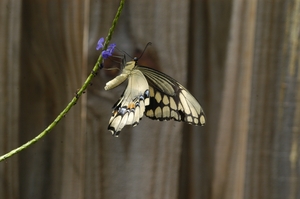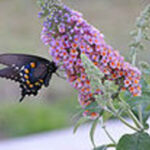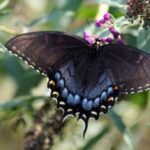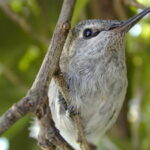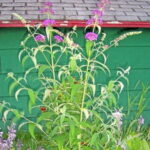It’s a little bit like falling in love with someone’s blue eyes and then finding out they are colored contacts. I love the Blue Porterweed growing in my Florida butterfly gardens even though I’ve discovered I don’t possess the true Florida native version.
On the positive side, my exotic Blue Porterweed does attract a variety of beautiful butterflies including an Eastern Tiger Swallowtail that recently came to perch on its tall spikes. And my exotic stays in check by dying down in the winter and reseeding in the spring without becoming too aggressive. It’s easy to weed out the ones I don’t desire.
A perennial shrub, Stachytarpheta jamaicensis is in the Verbenaceae family, which is highly valued for attracting butterflies and serving as a nectar source. In terms of its USDA hardiness, it thrives for people in the 10 through 11 tropical zones.
According to experts, it’s not unusual for the non-native porterweed, Stachytarpheta urticifolia, to be mislabeled as native.
Here are a few tips so you don’t make the same mistake I make when purchasing a Blue Porterweed from a nursery.
No. 1: Check the label for height. My non-native grows upright and reaches five feet or taller by autumn. The native Blue Porterweed is low growing, speading more in the horizontal direction to just one or two feet.
No. 2: The native Florida species is the Jamaica Porterweed or Stachytarpheta jamaicensis so ask or check the label carefully before purchasing.
No. 3: The leaves of the native Blue Porterweed tend to be light green and dull. The leaves may be slightly hairy on the bottom and smooth on the top. The exotic species may have dark green leaves.
No. 4: The flowers on the native and the flowers on the exotic plants last only one day so don’t use that as a way to differentiate the two.
No. 5: Plant passion vines in the same yard as the Blue Porterweeds – whether native or exotic porterweeds. The Gulf Fritillary and Julia butterflies use passion vines as a host plant and then use the porterweeds as their nectar. The Large Orange Sulphur and Eastern Tiger Swallowtail are also attracted to the porterweeds.
No. 6: Leaves of the native Blue Porterweed are eaten by the Tropical Buckeye caterpillars as another incentive for planting the right species.
No. 7: Other common names for Stachytarpheta jamaicensis include Blue Snakeweed, Brazilian Tea, Jamaica vervain and Devil’s Coachwhip. But nurseries may still mislabel the native and exotic plants so always check the scientific name. In this case you are looking again, for, “Stachytarpheta jamaicensis” or Jamaica Porterweed.
No. 8: Also called the Nettleleaf vervain, the Stachytarpheta urticifolia is an exotic that is native to tropical Asia.
No. 9: Beware of a hybrid of the native and the exotic. The hybrid named Stachytarpheta xintercedens grows just 2 to 3 feet tall, appearing even more like the native.
No 10: Once planted, Blue Porterweed is a Florida-friendly plant because it does not need a lot of excess water. Florida for many years now has struggled with droughts so the plant is perfect for those who practice water conservation or xeriscaping.
Finally, not everyone believes Blue Porterweed is a true Florida native plant. Some say the seeds were brought over by Jamaican settlers in the late 1700s (Hence the name Jamaica Porterweed). No matter, the more native version is ideal for a Florida butterfly garden.
For my gardens, I plan to keep the exotic Blue Porterweed until I’m able to replace it with natives. In the meantime, I’ll still enjoy hours of butterfly watching — especially in the late summer and autumn months when its butterfly visitors would take up a 500-page guest book!
